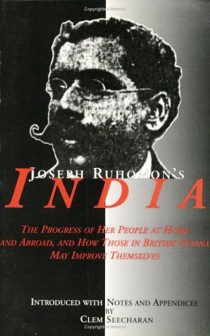That part of Guyanese literature that may be described as East Indian literature is indistinguishable from the totality of the nation’s writing in terms of styles, themes, subjects and other concerns of authors today. Yet, literature written by or written about Indians in Guyana attracts great interest and makes up a major part of the writing. There is that area within the literature that is interesting because it treats with the Indian presence, the ethos and other cultural subjects concerning the lives of Indian descendants in Guyana and the troublesome issues of race.
Reflection on East Indian literature in Guyana goes back to the nineteenth century and yields very interesting results. While one may want to divide this into literature written about Indians in Guyana or by Guyanese who belong to that ethnic group, that is not the most rewarding approach. It is far more interesting to take the literature as a whole and consider the varied and important elements contributed by the Indian presence.
 The very beginnings demonstrate the complexity of simple subdivision. And perhaps the most appropriate place to start is with what Clem Seecharran believes to be the first known publication by an East Indian in the Caribbean. This work was first presented by Joseph Ruhomon who was very concerned about the conditions under which indentured immigrants lived in his native British Guiana. The resulting publication in 1894 bears a title that is as lengthy and cumbersome as it is self-explanatory (titles like these were not unusual in the nineteenth century) – India: The Progress of Her People at Home and Abroad and How Those in British Guiana May Improve Themselves. Note that Ruhomon’s interest was in India and her people, that is, the people of India abroad in British Guiana. Culturally and socially they were not living like true Indians; they had problems of literacy, culture, social and economic condition and needed to improve themselves. He was dissatisfied with their condition and sought to stir them into advancement.
The very beginnings demonstrate the complexity of simple subdivision. And perhaps the most appropriate place to start is with what Clem Seecharran believes to be the first known publication by an East Indian in the Caribbean. This work was first presented by Joseph Ruhomon who was very concerned about the conditions under which indentured immigrants lived in his native British Guiana. The resulting publication in 1894 bears a title that is as lengthy and cumbersome as it is self-explanatory (titles like these were not unusual in the nineteenth century) – India: The Progress of Her People at Home and Abroad and How Those in British Guiana May Improve Themselves. Note that Ruhomon’s interest was in India and her people, that is, the people of India abroad in British Guiana. Culturally and socially they were not living like true Indians; they had problems of literacy, culture, social and economic condition and needed to improve themselves. He was dissatisfied with their condition and sought to stir them into advancement.
Ruhomon (1873-1942) was the first Indian intellectual native to the colony and worked with others, including his brother Peter Ruhomon, to improve the cultural life. Their work led to the formation of many cultural and social clubs with lectures, intellectual discussions and other educational activities as part of a major cultural upheaval among Indians in BG in the period covering the 1920s to the 1940s. Intellectuals, professionals and writers emerged out of it, including poets CEJ Ramcharitar-Lalla, JW Chinapen, dramatist Basil Balgobin and writer, dramatist and cultural matriarch Rajkumari Singh. A newspaper, The People, and a journal Indian Opinion also arose out of that sustained movement, which, after Ruhomon’s activities, started with the clubs in 1916, including the British Guiana East Indian Association, the East Indian Young Men’s Society, the Corentyne Literary and Debating Society and the British Guiana Dramatic Society.
 One of the very significant factors however, was the main cultural focus at the core of these movements and the way it followed Ruhomon’s interest in India. The emphasis was on culture and literature of India, the land of their ancestors, rather than what was developing in the lives of “her people abroad” in the colony of British Guiana. It was this life among the folk, the peasants and estate workers that was seen as being in need of “improvement”. The focus was on literature and cultural standards from India rather than those which were developing in the villages, rice fields and sugar estates in BG.
One of the very significant factors however, was the main cultural focus at the core of these movements and the way it followed Ruhomon’s interest in India. The emphasis was on culture and literature of India, the land of their ancestors, rather than what was developing in the lives of “her people abroad” in the colony of British Guiana. It was this life among the folk, the peasants and estate workers that was seen as being in need of “improvement”. The focus was on literature and cultural standards from India rather than those which were developing in the villages, rice fields and sugar estates in BG.
Interestingly, the first writers to treat with these were not Guianese or East Indian. An Englishman with a deep concern for the immigrant workers in the colony, Edward Jenkins, who was ironically born in 1838, the very year that they first arrived in BG, wrote the first novel treating the subject of these immigrants as they lived in the colony. The novel Lutchmee and Dilloo: A Story of West Indian Life (1877) begins in India and follows the main characters after they made the voyage across the kala paani. The second such novel was by a Tobagonian, Albert Raymond Forbes Webber (1880-1932) who settled in and made major contributions to journalism, commercial and political life in BG. He wrote Those That Be In Bondage: A Tale of Indian Indentures and Sunlit Western Waters (1917) about the immigrants on the sugar estates.
While both of those works of fiction were quite in the tradition of British Victorian writing, the third was the first by a Guyanese and the first to be totally local, native and original, but still not written by an East Indian. Edgar Mittelholzer produced Corentyne Thunder in 1938 and got it published in 1941, giving a thorough study of the Corentyne peasants and their environment. This “tale of Ramlogan the cowminder” and his two daughters might not be a pretty picture, but it is an important chapter in the development of the literature. Much was written during that time, but after Mittelholzer, it was a long period before Indian writers turned to these subjects.
Ramcharitar Lalla saw it necessary to document Guianese Indian Poetry in an anthology in 1934, which included a number of local poets including Peter and Joseph Ruhomon, and some of them are again featured in AJ Seymour’s collection in Kyk-Over-Al more than 10 years later. But what is very significant about these samples of Guyanese Indian verse is that they are very much products of the poetry of their time. That is, they are written in the style, language, form, and on subjects belonging to 19th century Romantic and Victorian poetry, typical of the entire Caribbean at that time. The editor Ramcharitar-Lalla himself is the most progressive in his “Weeding Gang”, which comes closest to a local Indian poem and may be the first truly Guyanese poem in local Indian literature.
The currently available unfathomable wealth of Indian Guyanese literature, however, did not get properly kick-started until the 1960s with the emergence of playwright and fiction writer Sheik Sadeek. He produced a series of mostly one-act plays that went straight into the lives, environment, social and economic situations of the people such as Goodbye Corentyne and Black Bush. His best known novel, Song of the Sugarcanes and short stories are mainly about the estates and the injustices of the colonial setting. Sadeek set off local Guyanese drama and an East Indian literature that saw Rooplall Monar taking up the tradition in the 1980s. Monar’s Backdam People (1987) and Janjhat are fundamental to the way this literature took off in the period starting in the 1980s.
A literature emerged in the 1990s that began to dissect in direct and candid ways never seen before the specific Guyanese political issues of the 1970s and eighties as well as the racial disturbances of the 1960s. No local writer except Martin Carter confronted these while they were happening, but others took them up after some creative distance. The Indian writers, many of them resident overseas, began to come into prominence with the rise of their literature exorcising those bitter experiences. Interestingly enough at the same time, they began to treat with the Indian presence in Guyana, the religious and cultural traditions and the ethos. One of the best examples of these is the novel Cosmic Dance by Harischandra Khemraj (1994), an action-packed drama and one of the most brutal criticisms of Guyanese politics under PNC rule. In allegorical form it also uses the concept of the cosmic dance of Lord Shiva in Hindu mythology to narrate an unforgettable episode that drags an unwilling medical doctor into a dangerous political and ethnic conflict. The same political period is fictionalised by journalist turned novelist Narmala Shewcharan in Tomorrow is Another Day (1994).
David Dabydeen’s Coolie Odyssey (1989) linked history with the contemporary issues of migration and its push factors while his The Counting House (1996) treats not only indentureship, but the deep-rooted Indian experience. This experience is approached in a different way by Moses Nagamootoo in Hendree’s Cure (2001), a novel set on the Corentyne about descendants of the Madrassis recreating their cultural realities in multi-ethnic situations. Added to these, the most startling confrontation of ‘Indianness’ after the largely unknown Guyanese play Pillars in the Mud about the racial war of the 1960s, is Till I Danced With My People I Never Danced Before (2005); a play about Indian traditions by Sharda Shakti Singh, who happens to be a descendant of the BGDS and Rajkumari Singh.
Following that period, works which explored ‘Indianness’ and the ethnic spiritual experience such as in the poetry and fiction of Sasenarine Persaud, moved into a variety of other areas. Hari Sukul’s The Nine Ghosts of Old Hague House (2010), a different kind of novel, moves through Hinduism into the high realm of spirituality and the occult. Another notable example is the new novel by Clive Sankardyal, Brown Curtains (2002). From the safety of time and distance, Sankardyal reveals many secrets of teachers sneaking out of Guyana in the 1980s to work in St Lucia (some of which might be autobiographical) mixed with frank revelations of racial conflict.
Some of the leading Guyanese writers of Indian descent are known for their universal preoccupations and this is why it is now very difficult to generalize about the writing. Mahadai Das, among the nation’s leading women poets to date, and novelist Jan Lowe Shinebourne have written much in this vein. David Dabydeen and Cyril Dabydeen have covered a range of issues including exile, migration and issues prompted by their residency in other countries. David’s major area of research and fiction is African slavery and the Black British experience. He has grown to be one of the leading novelists in the United Kingdom with novels like Harlot’s Progress (2000), which makes him a significant case of a major Guyanese Indian writer engaging diverse subjects.
It is very easy to celebrate East Indian writers who are among the best of Guyanese artists. However, the current state of contemporary Guyanese Indian literature is a mix of works written about Guyanese Indians by members of other races, such as Roy Heath’s The Shadow Bride (1989), works by Indians about Indians, or works by anyone on those subjects, making it difficult to separate work which reflects the Indian presence in Guyana from the large corpus of Guyanese literature.









